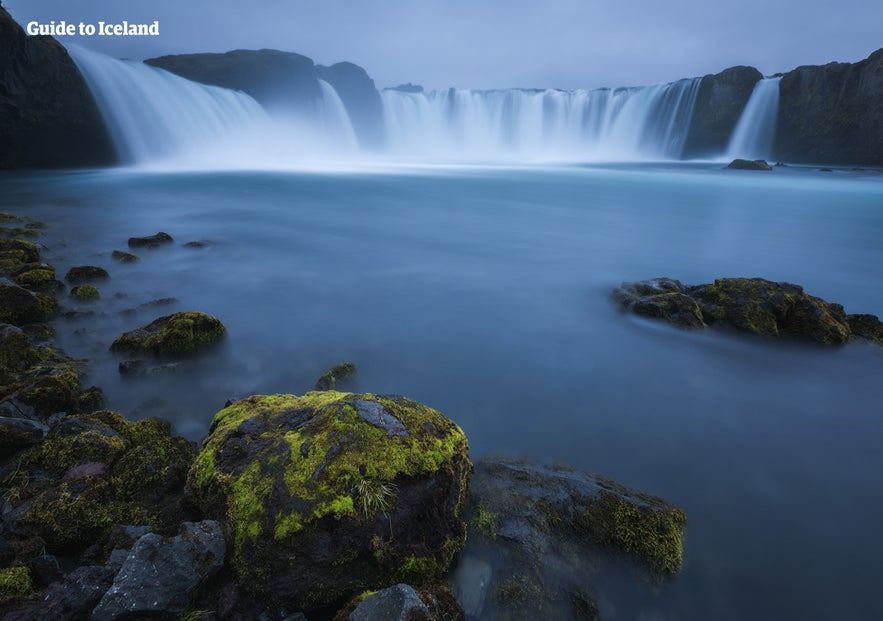
Goðafoss waterfall is located in the river Skjálfandafljót in north Iceland, the fourth-largest river in Iceland. It is one of the most spectacular waterfalls in the country, falling from a height of 12 meters (39 feet) over a width of 30 meters (98 feet).
Day tours in North Iceland, especially Akureyri tours, often visit the waterfall, and it is easily accessed by those who rent a car. It is also a highlight of many guided packages and self-drives, such as this 10-day summer vacation.
Miksi sisältöömme voi luottaa
Guide to Iceland on Islannin luotetuin matkailusivusto ja auttaa vuosittain miljoonia matkailijoita. Kaikki sisältömme on paikallisten asiantuntijoiden kirjoittamaa ja tarkastamaa – he tuntevat Islannin läpikotaisin. Voit luottaa siihen, että saat meiltä ajankohtaista, paikkansapitävää ja luotettavaa matkailutietoa.
History of Goðafoss
The name Goðafoss means either waterfall of the gods or waterfall of the 'goði' (i.e. priest/ chieftain). The reason for this is its fascinating history.
When Iceland was first settled in the 9th and 10th Centuries, the vast majority (those who were not slaves, at least) were Norwegians who followed the Old Norse religion, worshipping deities like Thor, Odin, Loki, and Freya. However, after the Commonwealth was established in 930 AD, pressure to convert began to push from Christianising Europe.
By 1000 AD, it seemed that Norway would almost certainly invade if the country were to stand by its pagan beliefs. The issue was thus discussed at Þingvellir, where the parliament met once a year. The lawspeaker at the time, the Ásatrú priest (or goði) Þorgeir Ljósvetningagoði, was given the responsibility to make the decision.
It is said he lay under a fur blanket for a day and a night in silence, praying to his Old Gods for the right decision. Eventually, he emerged and said, for the good of the people, Christianity would be the official religion, but pagans could practice in private.
To symbolize his decision, he returned to his home in north Iceland and threw idols of the Old Gods into a beautiful waterfall. Since then, it would be known as Goðafoss.
Getting to Goðafoss

Goðafoss is located in north Iceland, on the Ring Road that fully encircles the country. It is considered part of the Diamond Circle sightseeing route.
This trail also takes visitors to the Lake Mývatn area, Dettifoss Waterfall, Ásbyrgi Canyon and the town of Húsavík.
Mývatn is a beautiful lake, filled with a wealth of birdlife, and it is renowned for its incredible surroundings, which include fortresses and lava, geothermal areas, craters, and basalt pillars. Dettifoss is another waterfall, and though it does not have the history of Goðafoss, it has much more power; it is, in fact, the most powerful waterfall in Europe.
Ásbyrgi Canyon, meanwhile, is also linked to the Old Norse Gods. Its perfect horseshoe shape was said to have been created by the stomping of one of the hoofs of the eight-legged steed of Odin. The final destination on the Diamond Circle is Húsavík, the best place for whale watching in Iceland.
Outside of the Diamond Circle, Goðafoss, is easily reached by travelling for 45 minutes east by car from the capital of the north, Akureyri.
This is the largest settlement outside of the Greater Reykjavík Area and is a perfect place to stay for those traveling the circle around the country. It is a renowned cultural centre, with many museums, galleries, and the world’s northernmost botanical gardens. Many tours depart from here.
Goðafoss can be reached throughout the year, although drivers in winter will want to be sure that they rent a four-wheel-drive vehicle.









